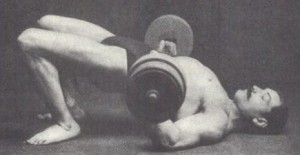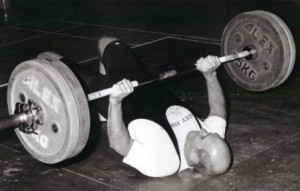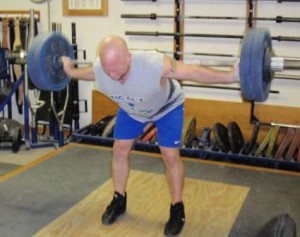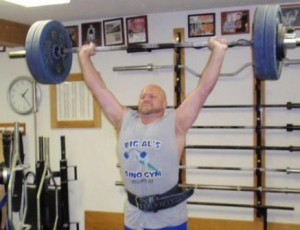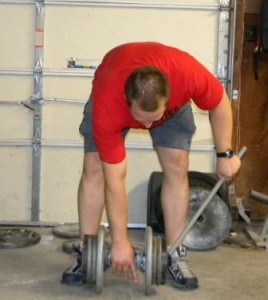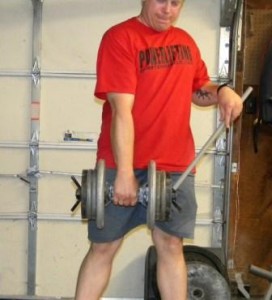The Pullover and Push Part 2 – History
by Al Myers
Just like the stories of Milo Steinborn developing the Steinborn Lift because squat stands didn’t exist, Old Time great strongmen like Arthur Saxon and George Hackenschmidt were performing the Pullover and Press and the Pullover and Push on the floor before the bench press existed. This was the only way at the time to do a supine press since benches for bench presses weren’t around yet. The Pullover and Press (where the lifter lies flat and performs a strict press unlike the Pullover and Push where the lifter can arch) was performed before it “evolved” into the Pullover and Push. I can just imagine the lifter’s comments at the time when the first lifter did “the Push” instead of “the Press”. Much like the comments I here now when you see big bench presses put up with an armored reinforced bench shirt on!! Such comments as, “THAT’S not a real bench press!”, “If you wear a bench shirt, you’re a cheater!”. And so on. Back then I bet you would hear comments like, “THAT”S not a real pullover and press!”, and “If you got to bridge like that, you’re a cheater!”. So, really nothing has changed in over 100 years of arguments and debates involving supine pressing! My opinion is that the Pullover and Push is a different lift compared to the Pullover and Press (just as benching with a shirt on is compared to without) and everyone should treat it that way. Arthur Saxon even made this comment regarding the Pullover and Push in his book The Development of Physical Power “A more genuine test, perhaps, is to lay perfectly flat, and slowly press the barbell overhead.” And this came from our hero Arthur Saxon who HELD the record in the Pullover and Push for some time with a lift of 175 kilograms in the early 1900’s.
The Pullover and Push was contested heavily between 1900 and 1930, at which time the more modern Bench Press gained popularity. The Pullover and Push pretty much disappeared as a competitive lift after that, and most weightlifters at the time didn’t even know how to perform it. However, the Pullover and Push made a resurgence in the mid 1980’s with the organization of modern-day All-Round Weightlifting. It is now one of the most popular lifts in All-Round competitions. Of the over 200 official All-Round lifts, I can count on at least one meet per year will have the Pullover and Push in it.
Some of the best Pullover and Push lifters among Old Time Strongmen include Arthur Saxon (175 kg), Harold Wood (175.2 kg), and George Lurich (201.5 kg). Lurich set this World Record in 1902 in Leipzig, Germany, but since he was wrestling professionally at the time, this was considered “the Professional Record”. Modern day All-Rounders have posted significantly higher records, possibly due to modern day bars and plates that allow the bar to reach the chest/abdomen easier. These are the modern day best Pullover and Push records – all of which were done in official competitions.
Adrian Blindt (70 kg BWT) – 177.5 kg
Rick Meldon (80 kg BWT) – 190 kg
Phil Anderson (90 kg BWT) – 202.5 kg
Steve Angell (100 kg BWT) – 180 kg
Bob Burtzloff (110 kg BWT) – 215 kg
Al Myers (120 kg BWT) – 204.1 kg
The research for these modern day record holders was done by Roger Davis, who wrote a splendid article about the Pullover and Press and the Pullover and Push in the March 2009 issue of MILO. Roger’s article is the best article covering these lifts that has ever been written, and if you get a chance and want to read about the Pullover and Push in more detail than what I have done here, I recommend you get that copy of MILO and read it.
Tomorrow I am going to cover techniques used in the Pullover and Push, and even give away some of “my secrets” that I have learned about this lift over the years.
